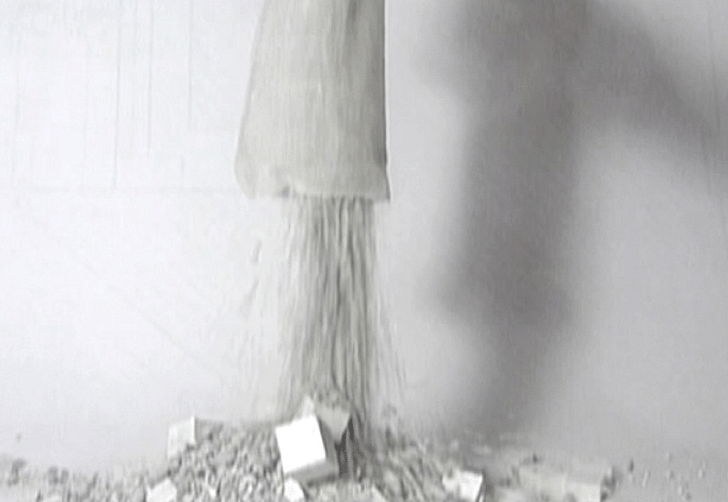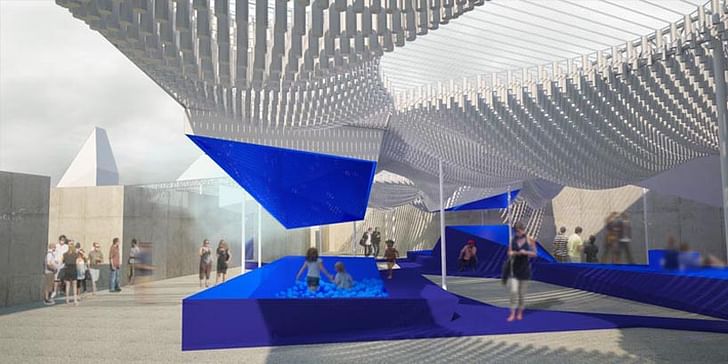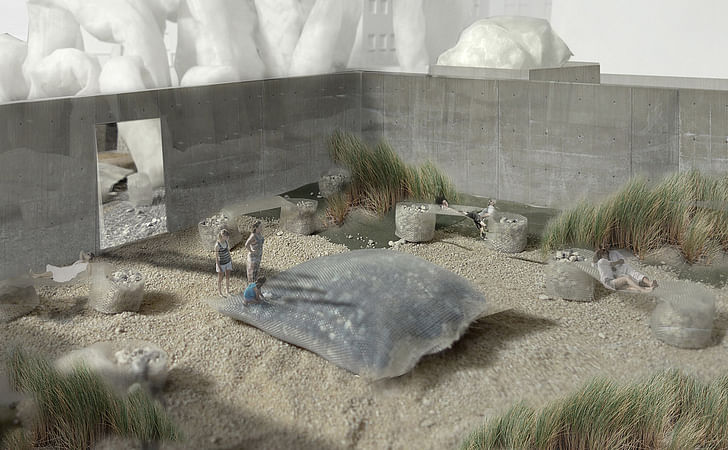

With the winning PS1 entry by Interboro Partners being installed right now, Archinect takes a moment to catch up with Formlessfinder, winner of the Peoples' Choice Award, to talk about the how and the why of innovative architecture.
By hosting the first annual PS1 Peoples’ Choice Awards Archinect wanted to accomplish two goals. First, to bring more attention to the full compliment of PS1 entries, thereby mining the competition as an annual zeitgeist of contemporary American architecture. And second, to measure the breadth or spread of that zeitgeist as a way to understand the variety of architectural interests not just as parallel worlds, but ideas that exist in conversation with each other.
In essence, we want to celebrate MoMA’s investment in contemporary architecture by doing more with it. For an institution as large as MoMA, the PS1 YAP is understandably a small initiative. Even in dollar terms the competition is a small investment. Yet from the flip side, from the perspective of the generally young offices who are invited to compete, simply being nominated is a significant vote of confidence, and winning can be an office-changing accomplishment.
Archinect is excited to begin this experiment in extending the contribution of the PS1 YAP competition: more ideas, more discourse, more visibility for the competitors, and ultimately more meaning. We’re interested in a very basic question: how might the spread of entries to the PS1 competition be used as a way to better understand the state of American architecture at this moment?
With the gracious participation of the competition teams, we were able to gather most of the entries (thank you Formlessfinder, IJP, Interbobo Partners, MASS Design Group) and offer them to the Archinect community on a level plane. The voting trajectory itself was notable: it began as a neck and neck battle between the two youngest teams, one comprised of Princeton students and one of students at Harvard. Eventually the Princeton-based Formlessfinder pulled ahead to win the Peoples’ Choice Award for 2011. To the best of our knowledge this is the first time that two student teams were competing, so that fact itself is notable because it shows an encouraging willingness on behalf of MoMA to take a chance on unproven teams.
Perhaps the two leaders benefitted from being connected to university communities that feature scores of willing voters looking for distractions from studio deadlines, but we read it as a meaningful point of difference between two emerging ways of thinking about, talking about, and making architecture.
On the one hand, MASS is interested in putting architecture to work by using formal and material aspects to seduce their visitors into engagement with questions of ecology and social justice, thereby hoping to prove that these concerns are not mutually exclusive. Formlessfinder seek rather the opposite: to plumb the depths of architecture in search of material and formal opportunities that are so compelling they might induce new social and cultural realities.
The good news is that underpinning these two manifestations of architectural ambition is a singular hopefulness. The differences arise when these teams attempt to connect their own aspirations for an architecture capable of making an impact with more specific thoughts about where that impact is most likely to happen, why it needs to happen, and how it might be best accomplished.

MASS’ entry which seeks to use form and shiny things (literally) to attract attention to global causes on other continents is not without a cynical tinge. In an interview after the Peoples’ Choice voting concluded, MASS claimed that “architecture has become irrelevant, isolated from serving the public and instead focused on little more than solipsistic formal agendas,” going on to propose that their goal is to “[show] that socially responsible architecture IS well designed architecture.” Here we find the nugget of their critique: the dominance of ‘one-liner’ architecture has left the discipline disconnected and irrelevant.
In a point of coincidence, Formlessfinder sees the same problems with contemporary architecture, but they arrive from a different angle: “people are tired of formally driven architecture, and especially tired of the search for ever-more-complex geometry encouraged by most digital design today. There also seems to be a growing concern with the degree to which images are dominating.“
Formlessfinder are interested in engaging matter on its own terms. The most unique aspect of their entry, and perhaps what helped them win the Peoples’ Choice Award, was the literal weight of it. “No one has ever brought the sheer amount of mass we proposed to the site, and all that material has interesting benefits in terms of acoustics and thermal mass cooling.” Noting that most proposals skew towards lightness, Formless sought to use weightiness to provide ”a real sense of enclosure… [and] opportunities for bodily interaction with our structure.”

Finding ways to represent the inherent instability of their proposal was a challenge that Formlessfinder took as an opportunity to think about how architecture is communicated. They don’t want to illustrate space with the conventional renderings because these fail to capture physics, time, and instability. Instead they favored video and models as a way to develop and communicate their ideas in parallel, going so far as to fill the room on the day of PS1 judging with full scale prototypes.
This is also evident in their entry for the PS1 competition where collage is favored over renderings and drawings: a technique that would appear gutsy at a time when photorealistic renderings are the currency of architectural representation. A collection of videos similarly eschew the standard walk/run/fly through in favor of demonstrating the tectonic logic of the proposed bag arch and its contents in a slightly esoteric fashion.
By addressing tectonics and representation the Formlessfinder entry is an architectural proposal designed for architects. It speaks directly to the discipline on a number of levels. Some of which, like the way in which the ideas are expressed visually, are intensely critical of business as usual.
Under the surface of these two proposals we find competing ideas about how to renovate the profession. MASS’ proposal looks outward by arguing that the current ‘how’ of architecture is sufficient if only it could be oriented towards a more socially-engaged ‘why’.
Meanwhile, Formlessfinder have turned inwards, reflecting on the history of the discipline to identify opportunities in clear contrast to current practices. In seeking new answers to why architecture matters, they are exploring the ‘how’ of production and representation. In a culture of litigation, the formless is as risky as it is enticing. After all that’s the point of a competition such as the PS1 Young Architect’s Program: to risk and be rewarded for it. Sometimes.
Best of luck to all of the PS1 2011 runners up and thanks for giving us a glimpse of where the profession is headed.
3 Comments
Great article, Bryan.
I have to say that, while there was a lot to love about it, I thought the forms of the MASS proposal were imperfectly integrated into their social agenda. It unintentionally mirrored the same condition that they seemed to critique. Compare that to the main formal move of the Interboro proposal, that literally just gets out of the way. Even so, this question of the formal or aesthetic determinacy of work that's primarily about social organization is still unresolved. Mostly, that's exciting.
The Formlessfinder proposal has a lot going on, and in a parallel world, this kind of work, along R&Sie's and some other progenitors, remains the most vital thread to come out of formal and material experimentation. It's a great project, viva la Matter Battle!
In defence of MASS, I don't think they're unintentionally mirroring the same condition they're critiquing as much as they're deliberately trying to co-opt that condition towards a social agenda. I'm very sympathetic to that attempt, it's difficult (if not impossible) to be critical of a broader economic or political agenda, and then deliver a project within the system that remains true to the critique. Teddy Cruz has talked about this before, calling criticism that doesn't sully itself with engagement a sort of 'fake protest', and that a legitimate and effective response entails taking complex stances on such ambiguous issues.
But I do think it's important to ask to what degree are such tactics subversive and at what point are they a way to rationalize lazy work and undermine their own principles. I really like MASS, I think of all the firms they're doing the best work - but I do think this project leans towards the latter.
Block this user
Are you sure you want to block this user and hide all related comments throughout the site?
Archinect
This is your first comment on Archinect. Your comment will be visible once approved.